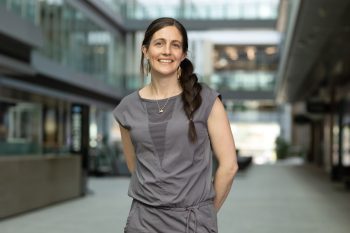When it comes to air quality, most people think car exhaust, industrial emissions and smog pose the biggest dangers. But Professor Jeffrey Siegel (CivE) says it’s the environment inside our homes and offices that should concern us most.
“We spend about 90 per cent of our time indoors,” says Siegel. “And in a place like Toronto, the air inside is generally dirtier than outside.”
Siegel and his team regularly collect air filters from furnaces in both private homes and commercial buildings and analyze what they find stuck to them. “It’s a very rich history of what you’ve been exposed to in the air: metallic particles, flame retardants, plasticizers and more,” he says about this process, which he has dubbed “filter forensics.”
Siegel and his team care about the kinds of pollutants they find, but they’re even more interested in measuring how much of each type is present in the filter. Based on the size of the house, the amount of time since the filter was installed, how often the furnace runs and other parameters, they can use those concentrations to estimate the levels of pollutants in the air over the life of the filter, and by extension, the effects on human health.
So what are the biggest concerns? “It’s an amazingly long list, but number one would probably be particulate matter,” says Siegel. These are solid or liquid particles that range in size from visible motes of dust to stuff that is so small it’s hard to see even with a microscope. The particles can be small pieces that broke off of something large — skin flakes or drywall dust — or they can form as aggregations of chemical compounds, such as volatile organic molecules from paint.
The health effects of these particles vary greatly depending on what they’re made of, their size and concentration. The link between smoking and lung cancer is well known. For other materials, such as the particles that come from cooking on a gas or electric stove, the subtle effects are still being teased out by scientists. Still, the general weight of evidence is that the more particles floating in the indoor air, the more likely people are to experience negative health effects.
So how do we keep our building air clean? The air filter in your furnace can do a lot, but only if you buy the right kind. “The average air filter does nothing for your health; it’s there to protect the equipment,” says Siegel.
Although they are slightly more expensive, better filters that have higher efficiency ratings or contain activated carbon are effective in combatting chemical pollutants such as ground-level ozone, which goes straight through traditional filters. One of Siegel’s recent studies has shown that for commercial and some residential buildings, the benefits of these filters justify their higher cost.
Some of the things that are often perceived as improving indoor air quality are not effective at all. Office plants, while nice to look at, offer almost no protection from indoor air pollution. “The average room exchanges its entire volume of air about once an hour,” Siegel says. “The amount of air that flows through a plant is tiny compared to that.” In other words, you’re better off changing your air filter than cultivating a small garden of ferns.
Another branch of Siegel’s research looks at the various bacteria, fungi and other microorganisms that can be found in indoor air. A growing body of evidence points to the importance of maintaining a healthy diversity in the microbial community that lives inside our own bodies, and the same principle might also apply to buildings. “We try and understand why the community in this building is different from the community in that one,” says Siegel. “The ultimate goal, and frankly this is far in the future, is to see if we can take advantage of this to improve the health of indoor environments.”
Siegel describes the world of indoor air quality as “amazingly unexplored” and says that’s a big part of its appeal for him. “What’s kept me in it is that it’s just so diverse,” he says. “I really love buildings, and I want to make a difference. For me, that’s a great fit.”



